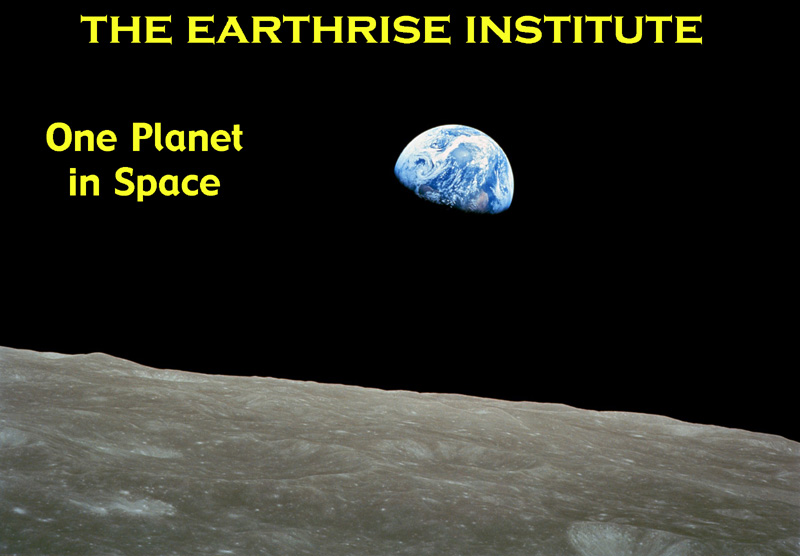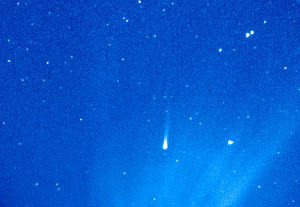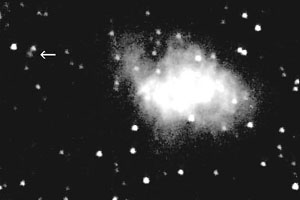|
|
|
 |
|
|
|
EARTHRISE PROGRAMS
|
|
|
|
(updated November 2006)
|
|
|
| Our facilities at the Earthrise dark-sky site (and other sites in the Earthrise network, once those are brought on-line) will be designed to accomodate a wide variety of educational and research programs, both on-site and remote. Furthermore, our facilities are intended to accomodate students at a variety of ages and educational levels, and in a very real sense, we define "students" as being anyone who is interested in learning about the universe around us. Thus, while our mission certainly involves working with schools and other educational institutions, we also will be partnering with science museums, tourism companies, and other related organizations to cater to as wide an audience as possible. |
|
|
| Once we are fully operational we anticipate having several telescopes (up to a half dozen or more) of several sizes available for use, including an eventual telescope in the meter-size range. We already own the first telescope to be based at the Earthrise dark-sky site, a 10-inch (25 cm) reflector donated by Meade Instruments. (We are looking for a donor to help us name this telescope.) Pending funding, our goal is to have this particular telescope sited and operational by about mid-2007, and to have it available for remote operations. In such a remote capacity this instrument, as well as the others that will be based at the Earthrise site, will be available for usage by students at schools, science museums, tourist destinations, and other similar institutions at a variety of locations around the world.
We will also be developing on-site activities that will be implemented at our dark-sky site and other Earthrise locations. Some of our on-site activities will be oriented towards "getting acquainted with the sky" programs that will be designed specifically for students and other individuals from urban environments who may not have many opportunities to spend time under a dark nighttime sky. Examples of such activities include basic familiarization with the constellations and visible planets, along with some preliminary instruction in the usage of small telescopes. Images of celestial objects taken by students with our telescopes can be provided to the students to retain as keepsakes.
|
|
|
|
Our telescopes will also be available for students, educators, and other interested individuals to pursue individual and group research projects. Through mentoring by established scientists and researchers, students who participate in these projects will be able to participate in a true "learning-by-doing" environment and play their own role in contributing to our scientific knowledge. Teacher training workshops, conducted by established researchers, will aid teachers in assisting their students in their projects, and also will provide them with knowledge to utilize in their classroom presentations.
To as wide an extent as possible, we would like the research programs carried out at Earthrise to be user-selected and user-defined. From a practical perspective, as we would like our participating students to work with established researchers when possible, our most detailed research efforts will be those with which Earthrise staff, and affiliated scientists, have expertise. We will continually be in the process of seeking out research scientists, including graduate students, who have expertise in a wide range of topics, and encourage these individuals to become affiliated with Earthrise so as to offer as wide a range in research endeavors as we can.
|
|
|
|
One area where we have established a strong research presence is in the arena of follow-up observations of comets and near-Earth asteroids. In 2000 we were assigned observatory code 921 by the International Astronomical Union's Minor Planet Center, and since then we have regularly submitted observations that have appeared in MPC publications. A sample image from our program, at right, is of Comet Petriew which was discovered in August 2001, and for which the Institute was the first institution in the world to obtain accurate positional data. |
|
 |
|
|
 |
|
|
| A specific example of how this particular program relates to the mission of Earthrise is illustrated by Comet Kudo-Fujikawa, which was discovered in December 2002. At top left is an image taken by Institute director Alan Hale two days after the comet's discovery; he was joined that morning by his then 10-year-old son Tyler, who assisted in the observations. The data obtained that morning was utilized in the first accurate calculations of the comet's orbit, and Tyler was credited for his role by the Minor Planet Center.
In late January 2003 as Comet Kudo-Fujikawa was passing by the sun it was imaged by coronagraphs aboard the SOlar and Heliospheric Observatory (SOHO) spacecraft; the image at bottom left is taken from the SOHO web page. Several instruments aboard SOHO were successful in observing the comet at that time, and in January 2004 NASA scientists released their findings that indicate how these observations provided important clues as to how planetary systems form in our galaxy. The observations that a 10-year-old student helped obtain on a cold morning in December 2002 thus ended up playing a small but important role in aiding our understanding as to how the Earth and our sister planets formed.
|
|
|
 |
|
|
 |
|
|
|
Many of our activities at Earthrise will be designed to provide ground-based support for various spacecraft missions. At right is an image of Comet Wild 2 taken in April 2003 as it was passing by the Crab Nebula in Taurus. This comet was encountered by the Stardust spacecraft in January 2004, and this image was one of the last to be taken of the comet before it disappeared behind the sun prior to the encounter. Our observations proved crucial in providing important navigational information for Stardust, and for a while this image was featured prominently on the Stardust web page. |
|
|
|
 |
Another research area where we expect to be able to make significant contributions is in the search for planets around other stars, especially via the "transit" method (i.e., by looking for the tell-tale dropping in brightness of a star caused by anorbiting planets' passing in front of it). We are partnering with the PlanetQuest project, and in fact one of our telescopes at the dark-sky site will be specifically dedicated for use by PlanetQuest. (We are looking for a donor to help us name this telescope.) We also expect to provide ground-based supporting observations for the Kepler spacecraft mission (artist's conception at left), which will also be looking for planets via the "transit" method, and which is currently scheduled for launch in 2008.
In theory, programs like PlanetQuest and missions like Kepler could detect Earth-sized planets that might be orbiting around these stars, and could give preliminary information about any such planets. Students participating in Earthrise thus have the potential of assisting in observations that may one day show that we are indeed not alone in the universe.
|
|
|
| The above are examples of the kinds of research projects we are currently performing and/or expect to perform at the Earthrise Institute. As Earthrise grows and as more scientists become affiliated with it, we can expect many more different types of projects will be included into our Earthrise activities, providing our students with the opportunity to participate in a variety of exciting astronomical and space-related endeavors. |
|
|
|
Back to main page |
|
|
|
|
|
|
|
|
|
|
|
|
|
|
|
|
|
|
|
|
|
|
|
|
|
|





